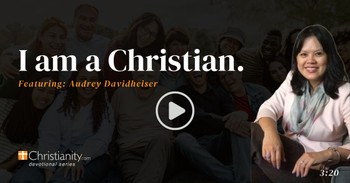Unity within the body of the church has been the dear desire of many Christians since the earliest churches were formed. Christ said of his disciples, “I have given them the glory that you gave me, that they may be one as we are one — I in them and you in me — so that they may be brought to complete unity” (John 17:22-23).
The Restorationist Movement emerged from a desire to accomplish unity between the churches in obedience to God.
Foundation Laying
The earliest Christian churches, recorded in Acts 2:42-47, was devoted “to the apostles’ teaching and to fellowship, to the breaking of bread and to prayer.” Every participant shared what they had, and they “sold property and possessions to give to anyone who had need.”
This early church body “broke bread in their homes and ate together with glad and sincere hearts, praising God and enjoying the favor of all the people. And the Lord added to their number daily those who were being saved.”
Even before the Restorationist Movement began in earnest, many Christians longed for the simplicity of early Christian worship. In the 19th century, those ideals spawned groups such as “Christian Churches, Churches of Christ, and the Disciples of Christ,” plus some groups, which veered away from the gospel such as “Jehovah's Witnesses, and the Mormon Church/Church of the Latter-day Saints.”
The Origin of the Restorationism Movement
Nigel G. Wright wrote an article for the Gospel Coalition discussing the variety found within the modern push for institutional unity, a phenomena subject to frequent change and one, which is impossible to pin down.
The head of the Restorationist Movement, Arthur Wallis, was convinced Christ was coming soon and that “the coming of Christ was to be greeted, not with the pessimistic decline of church life expected in pre-millennialism but by a gloriously restored church.”
He and a number of church leaders in England decided to prepare for the imminent return of King Jesus by bringing assorted denominations together. “Restorationism is a later development of the charismatic renewal movement which took root in Britain from the early 1960s.”
Several leaders formed a coalition of churches in which each leader would become a new “apostle” for Christ, spreading the gospel in a way, which best suited his Christian perspective.
The 1960s was a “decade of charismatic renewal” in a country bogged down by legalistic church attendance but lacking in Christian relationship both horizontally (brother to brother) and vertically (believers to Christ).
In the 70s, these church leaders would often combine forces for major worship events in London. Such events brought “visibility and influence [...] to Restorationism.” Attendees represented numerous denominations, and many of those taking part did not yet fully understand what Restorationism was.
A number of those who understood the nature of the movement did not fully agree with it. “Yet behind the public events were serious attempts to establish [...] covenant relationships and apostolic ministries.”
Troubled Unity in Restorationist Churches
Wright reports that “covenant relationships were more difficult to forge and sustain than was at first imagined.” In 1976, “the wider group of leaders was to divide [...] as deeper temperamental difficulties came to the surface.”
Restorationism has continued to develop and adapt, but in a fragmented, sometimes competitive way. Wright classifies participating churches according to his observations, referring to “left” and “right” extremes. His descriptors purposely generalize for the sake of brevity.
One would have to take a close look at any individual church to know to what extent a fellowship represents charismatic or legalistic tendencies, and most of them will combine elements.
“At the far right of the spectrum” are churches that “baptiz[e] only in the name of Jesus” instead of the Trinity. Another group emphasizes property sharing, with large households and an “aggressive and effective” type of street evangelism. They reach the disenfranchised people in their community.
Some churches are influenced by America’s prosperity gospel, leading them into false teaching. Meanwhile, the “shepherding movement” places emphasis on discipleship, but within a strict “patriarchal pyramid.” Wright describes “a sectarian ethos and an in-house group mentality.”
Certain Restorationist churches criticize fellow Restorationist fellowships, which focus on sharing the gospel within their insular groups. Their critics invest in domestic and foreign missions. This missional church ethos is known for church planting, allowing women to preach, and getting involved with social justice issues.
These superficial summaries do not reflect the deeper character of any single church body or denomination, but “the diversity of Restorationism should now be plain. [...] It is no surprise that the history of the movement gives evidence of the ability of its leaders to disagree strongly. The earliest expectations of an unbreakable covenant relationship binding all together have proven unsustainable.”
While one might hope that a movement concerned with unity would make “many of the traditions that developed during this period of Restorationism rejected all denominations and Christian groups, accepting only their own system as correct.”
In fact, many of the leaders became objects of worship and their teachings took the place of Scripture. Yet, “scripture calls Jesus the head of the church (Ephesians 1:22). The Bible speaks of the importance of unity in the faith and beliefs of Christianity” (Ephesians 4:1-6).
The Future of Restorationism
According to Wright, this movement is not finished. More recent, smaller events have demonstrated that unity is still desired. As we see in God’s Word, he wants Christians to be unified, even though it is easier in principle than in practice.
A new type of Restorationist Movement would be based on “mutual respect and the ability to disagree” if it succeeds at all, “while at the same time more closely akin to the kind of unity-in-coalition being sought among evangelical believers across the historic denominations.” They are still looking for gospel-centered unity, but without the seemingly impossible large-scale reform envisioned 50 years ago.
Arthur Wallis articulated a “passion for the recovery of NT realities.” For Restorationists to long for a certain standard indicates there is a “point of origin” they can test churches against in order to determine if they are following the beliefs, “patterns and forms” of the first fellowships following Christ’s ascension.
Every church since that time has in some way lost sight of what church was supposed to look like; of what Christ taught. The latest transformation starts where Acts began — with brothers and sisters in Christ looking after each other in the name of Jesus, knowing each other’s names, sharing the good news. It is less about institutions and more about relationships.
Truth can only be seen rightly “through the lens of Jesus Christ.” But his teaching clashes with much of what is being taught today, both within and outside the Restorationist Movement.
Jesus taught “a form of church life which is not hierarchical which looks to God rather than to his servants, and which sees authority displayed and practised in servanthood rather than domination.” As seen above in descriptors of participating bodies, this could prove problematic; much change is needed in order for certain churches to see the fellowship as Jesus taught and demonstrated it.
Although “the notion that the NT provides the final and infallible rule for the manner of the church’s life can be argued as a respected tradition of essential Protestantism, particularly its radical wing,” even Restorationists cannot agree on what that means. The future of this movement would appear shaky at best.
Is Restoration Possible?
Jesus always steered people away from legalism; from institutions. God did not seek law-abiding duty from his people. Psalm 51:16 puts it like this: “You do not delight in sacrifice, or I would bring it; you do not take pleasure in burnt offerings.”
Clearly, the human problem, sin, gets in the way of efforts to create an institution out of something, which should come naturally to those who follow the two most important commandments: Love the Lord completely and only; and “love your neighbor as yourself” (Mark 12:31).
Some people know how to love each other, and other people think they know how to obey God, but He commands that we do both. The Restorationist Movement will never really take off unless it is led by Shepherds who obediently serve their Lord and love God, their congregations, and communities.
Can we get back to an “Acts” type of church? Some churches do; many will. Christians can always strive to do better. Paul’s final exhortation for the church at Corinth suggests that unity is possible.
Finally, brothers and sisters, rejoice! Strive for full restoration, encourage one another, be of one mind, live in peace. And the God of love and peace will be with you (2 Corinthians 13:11).
Photo Credit: ©iStock/Getty Images Plus/Rawpixel


.jpg)

